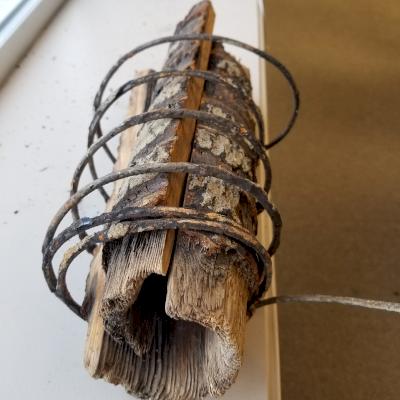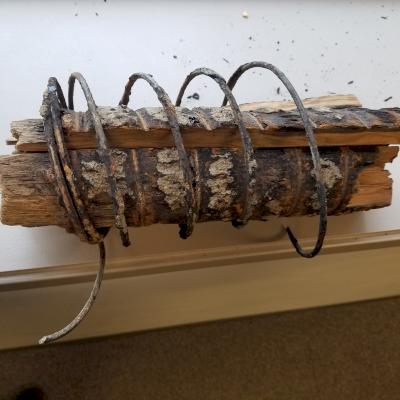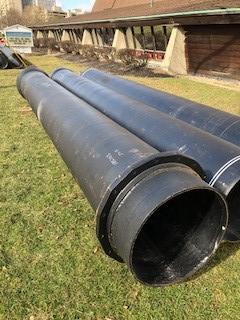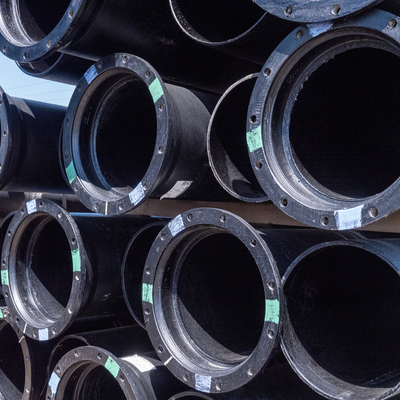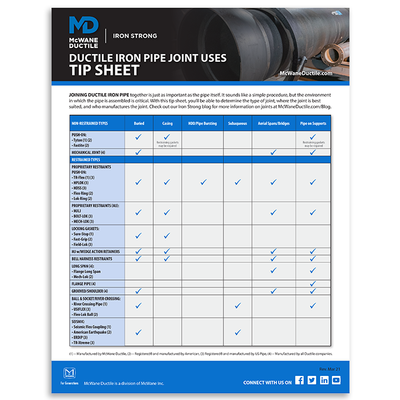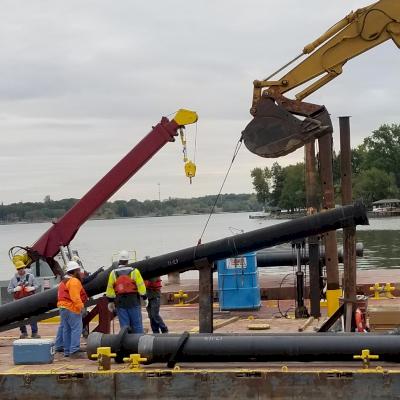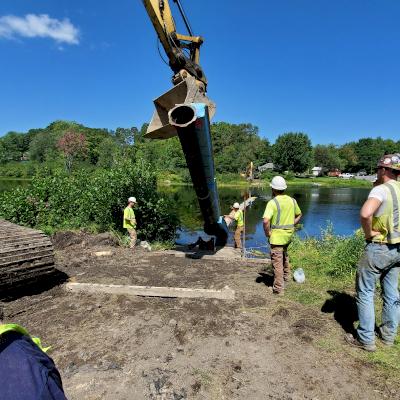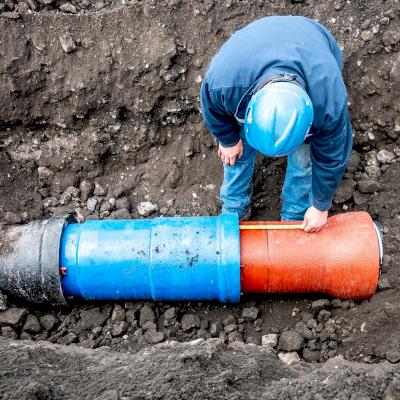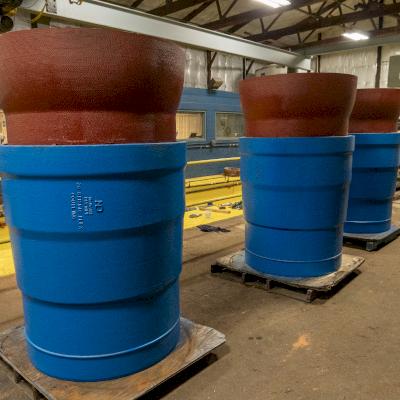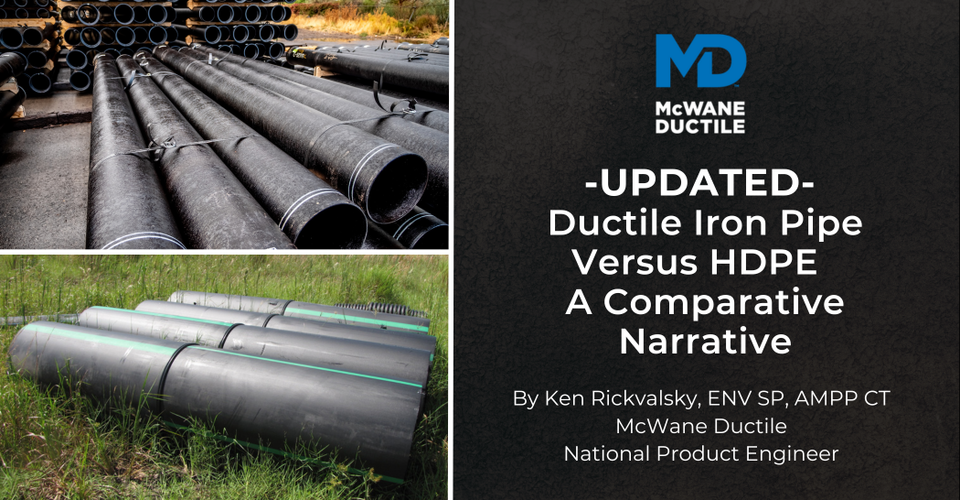Which Ductile Iron Joint Type Is Right for You?
There are various Ductile iron pipe (DI pipe) joints on the market. These different types of joint designs can now allow for additional benefits for various applications. Joining pipe together is just as important as the pipe itself. It sounds like a simple procedure, but the environment in which the pipe is assembled is critical.
- Some joints can restrain the pipe.
- There are joints with primary use for above-ground applications only.
- There are specialty joints that allow for deflection and expansion/contractions within the same coupling.
- Some joints allow you to span a greater distance than the pipe length.
- Some joints will enable you to assemble pipe above water and drop them off the side of a barge.
Whatever you can imagine, a DI pipe joint is most likely available to be used in the application. Let us look at the different types of DI pipe joints and find the right one for your application.
First, A Little History of Ductile Iron Pipe
Technology will consistently provide opportunities to enhance products and improve our quality of life. Piping for water lines is no exception. Imagine boring out a tree for water distribution, as once used. Those years are not that far behind us. In fact, wooden waterlines are discovered from time to time.
Centuries ago, the first type of joint was a flanged joint. They used leather between the flanges, which equals the rubber gasket of today. The next type of joint was bell and spigot. It was assembled with jute packing with lead poured behind the packing. With manufacturers always looking for better designs, various joints have been developed over the decades.
How the joints are assembled is another feature that has evolved over the years, especially since Ductile iron pipe became the norm back in the 1950s. You may experience different joints of pipe when repairing or replacing. Therefore, manufacturers will continue to publish information about their joints even though they no longer manufacture them because those joints are still in service.
Push-On Joints
The most common joint is the Push-On Joint. This joint is the simplest to install and is used in underground applications. Push-on pipe is a non-restraint joint. The full-circumference radial compression of the gasket between the bell and spigot forms the watertight seal.
You may take the necessary deflection if your line requires horizontal or vertical deflection once the joint is assembled. The size and the manufacturer of the pipe determine the allowable amount of deflection. The majority of push-on pipe allows for five degrees of deflection.
A five-degree deflection equals 19 inches in any direction – AFTER THE JOINT IS PROPERLY MADE.
PRO TIP: Using the 1-INCH PER FOOT RULE in the field is a safe and effective method to avoid over-deflecting joints. For example, 18-foot pipe = 18-inch / 10-foot field cut = 10-inches deflection, and so on.
Mechanical Joints
Mechanical Joint Pipe (MJ) is primarily used in fittings and valves. The mechanical joint may be configured as a non-restrained or retrained joint using a wedge action retained gland. These joints use the gland’s compression against the bell to wedge the gasket, forming a watertight seal.
The evolution of the MJ restraint gland provides the design engineer the option to eliminate the use of thrust blocks reducing cost and improving the efficiency of the project.
Mechanical joints may be deflected to achieve the desired alignment after the joint has been tightened. A common error in assembling a mechanical joint is not using lubricant on the gasket. Not using lubricant on the gasket forces the gasket into the gasket recess. Once the gasket relaxes, the bolts become loose and require tightening again.
Proprietary (Specially Designed) Restraint Push-On Joints
Proprietary Restraint Push-On Joints are unique to each manufacturer. These joints use the basic design of the push-on pipe to make the watertight seal. Each manufacturer has its own design that uses a deeper push-on bell and either specially designed wedges or rings to restrain the pipe against a welded bead on the pipe's spigot.
Restraint joints again provide the design engineer with excellent options to eliminate the use of thrust blocks. This reduces the cost and improves the efficiency of the project. Restraint joints are often required for high-pressure applications such as Pen Stocks or where operating pressures exceed typical conditions.
These joints also allow for different degrees of deflection depending on the design and size of the pipe. The deflection may be obtained after the joint assembly. These joints require minimal labor and time to assemble. These joints may be used in various installations including:
- buried
- in-casing
- horizontal directional drill/ pipe bursting
- subaqueous applications
- aerial spans/bridges
- pipe on supports
You cannot go wrong with the use of this type of restraint joint.
Proprietary Mechanical Restraint Joints
Proprietary Mechanical Restraint Joints are also unique to each manufacturer. These joints are special because they use an additional gland set behind a welded bead to achieve restraining capabilities. This gland forms a uniform compression on the entire spigot instead of wedges or set screws to achieve restraint.
Locking Gaskets
Locking Gaskets are used on push-on pipe to restrain the pipe. Locking gaskets are also unique to each manufacturer. There are currently other manufacturers developing locking gaskets. Before using locking gaskets from a supplier other than a DI pipe manufacturer, ensure they are approved for use with their pipe. Some locking gaskets are developed without the pipe manufacturers' written consent and may not work correctly on the pipe.
The restraint is engaged after the joint has been properly assembled, including deflection. Pulling back on the joint will “lock” the teeth in place. Restraint gaskets are an excellent option and are primarily used in smaller diameters (24 inches and down). Primarily used for buried applications, restraint gaskets are not recommended for above-ground applications, bridges, or vertical applications.
One thing to remember when using a locking gasket is that you only get one shot on assembly, and they are extremely difficult to disassemble once assembled, even when using a shim kit to deactivate the wedges within the gasket.
Wedge Action Retainers
Wedge Action Retainers are used with a mechanical joint to achieve a restrained joint that has deflection. The wedge action retainer takes the place of the MJ gland. Once you have assembled the joint, you may take the required deflection before tightening the bolts on the wedge. The wedges' bolts are designed to break or snap off once they reach the proper torque.
Wedge action retainers may be re-used if necessary. The key factor is to review the manufacturer’s instructions for re-use provided with the gland to obtain the proper torque for the restraint.
Is it the right Ductile iron pipe joint for the job? Be sure with this free and handy tip sheet listing various DI Pipe joints and their uses from McWane Ductile!
Bell Harness Restraints
A Bell Harness Restraint is an external restraint on push-on joint. The bell harness restraint utilizes a split gland behind the bell and a wedge action retainer on the spigot in front of the bell with a threaded rod secured by two nuts to hold the joint from disassembling when pressure is applied. This type of restraint is labor-intensive and requires additional excavation depth to properly allow the harness to be assembled around the push-on bell.
Flanged Pipe
The Flanged Joint was one of the first joints ever used. This joint should be used for an above-ground application. It is a rigid joint and does not allow deflection or expansion. Therefore, it is not recommended for underground use because of ground shift. Ground shift could damage the integration of the joint. The watertight seal is formed by tightening the bolts and compression of the gasket between the two flanges.
Grooved/Shoulder Joints
Grooved and Shoulder Joints use u-shaped coupling that goes around the plain end of a pipe that either has a groove cut into it or a shoulder threaded onto it. The u-shaped coupling fits into the groove to join/restrain the pipe.
Inside the u-shaped coupling is a gasket that compresses between the coupling and the pipe to form the watertight seal. This type of joint is used in above-ground applications. Grooved/shoulder joints should never be used in underground applications.
Grooved joints are available in flex or rigid configurations depending on the need for deflection.
Ball and Socket/River Crossing Joint
Ball and Socket Pipe has the greatest degree of deflection of any joint, for up to as much as 4.5 feet of offset for an 18-foot length of pipe. It ranges from twelve to fifteen degrees per joint. This joint describes itself.
Components of the River Crossing joint are machined to precise dimensions providing optimal deflection capabilities. Pipe class options are also available, providing installation options to either “float” or “sink” the pipe into place. Like the wing of an airplane, the structure and strength of this specialized joint serve to split any water or current it passes through harmlessly while it settles to the bottom of the waterway on its own.
This joint deflection may be horizontal or vertical. This deflection capability allows the pipe to be assembled on the bank or the back of a barge. The joints deflect as needed to adapt to the bottom of any waterway.
Seismic Couplings/Joint
A Seismic Coupling/Joint allows for expansion, contraction, and deflection in a specific area. Each Ductile manufacturer has its unique design that will allow for the ground to shift.
When you think of ground shifting, you may think it only happens during an earthquake. Ground shifting also occurs from liquefaction, such as when the ground becomes saturated after heavy rains and a severe drought. A fully restrained Ductile iron line with seismic couplings will withstand the soil's continually changing condition.
Conclusion
After reviewing the various joints listed here, there is definitely a joint that is right for your application. If you require any assistance to ensure you select the correct joint for your next application, please contact your local McWane Ductile Representative. We will be glad to help you design your project specifications to build an iron-strong project that will last for generations.


